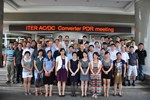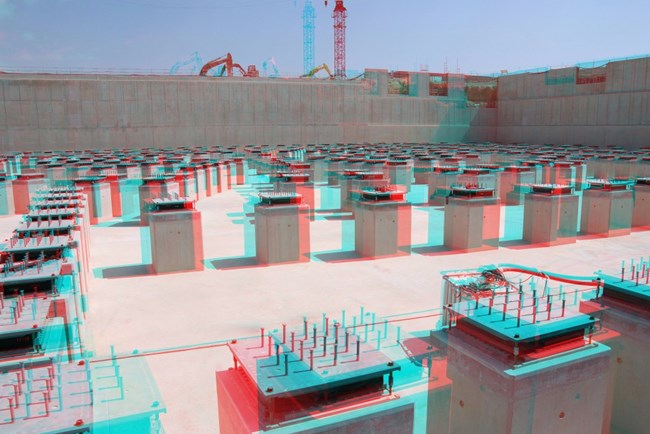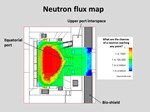The production of superconducting cables for ITER's large and powerful toroidal field coils is making remarkable progress: as of today, 330 tonnes of strands made out of Nb3Sn, a special alloy made of niobium and tin, have been produced in factories in China, Europe, Japan, Korea, Russia and the United States. In the pre-ITER world, global production was 15 tonnes a year. "The current production status represents 75 percent of the total toroidal field strands required for ITER," reports Arnaud Devred, Section Leader for Superconducting Systems. "Out of these strands, conductors for 6 out of the machine's 18 toroidal field coils have been produced."
The 18 toroidal field coils will produce a magnetic field around the ITER torus helping to confine and control the plasma inside. The coils are designed to achieve operation at magnetic fields up to 13 Tesla. They are made of cable-in-conduit superconductors in which a bundle of superconducting strands is cabled together and contained in a structural jacket. Unit lengths of theses cables—measuring 760 metres or 415 metres depending on their position within the coil—are then spooled into a D-shaped double spiral called a "double pancake," giving the structure the characteristic shape of ITER's toroidal field coils.
As of today, a total of thirty 760-metre unit lengths and thirteen 415-metre unit lengths have been manufactured by the procuring agencies in Japan, Korea, Russia and Europe, adding up to the material required for 6 of the 18 toroidal field coils.
"Quality tests are currently underway," says Devred, "to confirm that these unit lengths can be accepted for coil winding."
|
Finalizing a Procurement Arrangement signature and, at the same time, organizing Preliminary Design Reviews for two major systems is a very demanding task that the Chinese Domestic Agency and ITER Electrical Engineering Division performed between April and July 2012.
Assembling the documentation for the Procurement Arrangement for the pulsed power electrical network (PPEN) was finalized between January and June 2012, resulting in the signature of the corresponding Procurement Arrangement at the last ITER Council in Washington DC.
During that same period, the Preliminary Design Reviews for two other major power supply Procurement Arrangements had to be organized; these took place last week in Beijing for the poloidal field AC/DC power converters and for the reactive power compensators and harmonic filtering system.
It should be noted that for the Chinese Domestic Agency, these three Procurement Arrangements together exceed 35 percent of its total in-kind contribution to ITER.
Read more about the electrifying months for the Chinese Domestic Agency and the ITER Electrical Engineering Division here.
Everything you've always wanted to know about ITER vacuum requirements is to be found in a 44-page document (with an added 250 pages of appendixes) called the Vacuum Handbook.
The Vacuum Handbook was approved at project level in 2009 and forms part of the ITER Project Requirements—as such, it is a mandatory document to be followed by the ITER Organization, Domestic Agencies and suppliers of vacuum equipment to the project.
The term "vacuum requirements" encompasses the whole set of requirements that must be observed when designing, manufacturing, installing and testing components destined to operate in a vacuum environment.
The Vacuum Handbook, whose first edition was issued in June 2009, is "both general and specific," says Liam Worth of the ITER Vacuum Section and one of the main contributors to the document. "The Handbook contains a general background on the vacuum environment with the mandatory requirements pertaining to each of the ITER vacuum systems, with 21 appendixes providing the guidelines to achieve conformity with those requirements."
The Handbook's requirements should be clearly stated in all Procurement Arrangement documentation and are expected to filter down the suppliers.
Three years into its existence, the Vacuum Handbook "has been very well adopted," says Liam. "Its value can be judged by the number of deviations from the original edition. As of today, we have granted only one ..."
The value of the document is now recognized well beyond the ITER and fusion world. "Non-fusion industries have asked us for copies. And of course, we're happy to give them."
"The Handbook," says Liam, "recapitulates all our knowledge and know-how into one coherent document. All in all, this amounts to about one hundred years of experience."
At the coming 27th Symposium on Fusion Technology (SOFT) in Liège (Belgium), two satellite meetings on the Vacuum Handbook will be held—an opportunity to "explain the rationale behind the requirements, provide some training, and reach beyond ITER and the ITER Domestic Agencies to the wider fusion community as well as industrialists."
|
Earlier this month at the Culham Center for Fusion Energy (CCFE) in the UK, more than 40 scientists representing numerous institutes across Europe, China, India and the US attended the 7th ITER Neutronics Meeting. Although the word "neutronics"—used by scientists for the past 60 years—is still not listed in the Oxford English Dictionary, the field of research it refers to is essential to both fission and fusion development.
"I wrote to the editors of the dictionary and they promised they would soon remedy this situation," smiles ITER Nuclear Shielding Analysis Coordinator Michael Loughlin.
The field of neutronics covers the theoretical and experimental behaviour of the neutron, the electrically neutral sub-atomic particle that is present in every atom with the exception of hydrogen. In a fusion reaction, an extremely energetic (14 MeV) neutron is produced, providing energy that—in future fusion power plants—will generate electricity.
Shooting out of the plasma with tremendous speed, most neutrons will impact whatever stands in their way (some will just traverse the interatomic void as if matter didn't exist). The positive side of this process is that neutrons will heat the water circulating in the vacuum vessel wall; the not-so-positive side is that they will progressively alter and activate any materials they come into contact with.
Neutronics are at the heart of ITER design, and ITER "is driving the field of neutronics worldwide." The challenges faced by the field in ITER are completely new. "First, because ITER will be the first fusion device to have a significant production of neutrons," explains Michael, "and also because the device is very large and its structure extremely complex."
It is the neutronics experts' job to understand and model the behaviour of neutrons in order to shield both equipment and people from their impact. But individual neutrons can behave in many different ways. "They can hit different objects at different angles: some will bounce off; some will be absorbed; some will transmute; some will traverse matter unaffected ..."
Computer codes, data bases and statistical methods (the famous " Monte-Carlo method") enable neutronics experts to extrapolate the behaviour of the neutron flux from that of a couple billion individually tracked neutrons. "This way, we can know how many neutrons will reach the coils, how much they will heat them, etc. And this goes for every system in ITER, for they will all be affected by the impact of neutrons," says Michael.
Meetings like the one that was held in Culham provide neutronics experts from all over the world with an opportunity to discuss results, to define what analyses ITER is going to need and how they will be performed.
In terms of neutronics, "ITER is illuminating everything; it forces us to find solutions and the payback is already here in terms of applications for nuclear technology and safety, high-quality radiation maps, and calculation and training," says Michael.
Yes, definitely, "neutronics" deserves to enter the dictionary.
Namaste—in Hindi नमस्ते —is a common spoken valediction or salutation originating from the Indian subcontinent. It is a customary greeting when individuals meet, and a valediction upon their parting. A non-contact form of salutation is traditionally preferred in India and Namaste is the most common form.
On Wednesday 25 July the ITER Organization celebrated "Namaste India Day," the second ITER "Member Day." ITER Member Days are a new initiative that aims to highlight the unique, multicultural work environment of ITER by creating an opportunity for employees to discover each other's culture, music and traditional food.
For "Namaste India," all Indian ITER employees joined forces to put up traditional Indian decorations in and around the ITER Headquarters building entrance. Soft Indian music was playing outside in the hot summer sun as a variety of typical Indian dishes from a local caterer were brought in by Indian colleagues in colourful traditional costumes.
Before the guests were invited to taste this appetizing array, another typical Indian symbolic ceremony, the Lamp Lighting, was performed by ITER Director-General Osamu Motojima.
In the Indian tradition, daily worship starts with the lighting of the lamp. All auspicious functions, religious as well as social, start with the lighting of the lamp —the intellectual and spiritual significance of which runs deep.
The light symbolizes knowledge, which is the greatest wealth in life. Through knowledge, ignorance or darkness is dispelled. Knowledge also influences our good as well as bad actions. So, the lamp which is kept lit for all auspicious occasions is a witness to our thoughts and actions.
The lighting of an oil lamp, according to Indian tradition, has a further significance because oil symbolizes man's negative tendencies and ego, and as it burns these slowly diminish and eventually perish.
After this short but beautiful ceremony and some words of welcome from Director-General Motojima, Deputy Director-General Dhiraj Bora (from the CODAC, Heating & Diagnostics Directorate), and Shawn Simpson from the Agence Iter France Welcome Office, the ITER colleagues from India served around 500 of their peers from all over the world a tasty sample of traditional Indian cuisine.
Special thanks to AIF, ITER India, the Indian Domestic Agency, the Embassy of India in Paris and all Indian ITER employees for their contributions and efforts in making Namaste India Day such a success.
Pictures of "Namaste India Day" can be viewed here.
A year ago, when Newsline closed for the summer recess, the Tokamak Complex Seismic Isolation Pit was being readied for lower basemat concrete pouring, and cladding and roofing operations were far from finished on the Poloidal Field Coils Winding Facility.
Twelve months later, the landscape on the ITER platform has undergone spectacular changes. In the Tokamak Seismic Pit, the 493 plinths and seismic pads of the Seismic Isolation System are now in place, the backfilling between the retaining walls and the rock is almost complete, and the pouring of the next basemat—the Tokamak Complex basemat—should begin in October.
Located adjacent to the Tokamak Seismic Pit, the Assembly Hall area is the site of the latest construction campaign on the platform.
There, foundation work is ongoing to prepare for the construction of a 5,400 square metre area that will support the vast antechamber to the Tokamak Building where the machine components will be assembled. Pouring of blinding concrete and reinforcement works will begin in August, followed by concrete pouring activities that will extend into March 2013.
The Poloidal Field Coils Winding Facility is being prepared for the installation of the coil manufacturer's tooling. For six years, beginning 2013, the Facility will house the successive winding and assembly of ITER's poloidal field coils, the huge, circular coils that will be positioned horizontally around the toroidal field magnet system.
A giant plumbing operation—the laying of 1.6 km of concrete piping—began in March and will be completed in November. The deep underground drainage network under construction will collect rainwater from the platform buildings, roads and trenches, and evacuate the overflow of a "centennial rain," the extreme rainfall that, statistically, occurs only once every century.
Last but not least, the ITER Headquarters Building. For some 500 ITER staff and contractors, Moving Day(s) are scheduled to begin in the second half of September.
By then Newsline will be back to report—as it's been doing for the past five and a half years—on the news, large and small, of the ITER Project.
|








